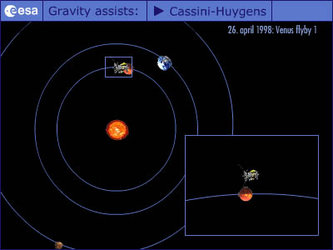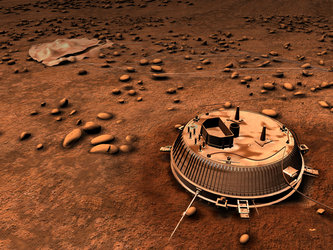Moons of Saturn sighted
Cassini-Huygens has sighted Prometheus and Pandora, the two 'shepherding' moons whose unpredictable orbits both fascinate scientists and wreak havoc on the Saturn's F ring.
Prometheus (102 kilometres across) is visible left of centre in the image, inside the F ring. Pandora (84 kilometres across) appears above centre, outside the ring.
The dark shadow cast by the planet stretches more than halfway across the A ring, the outermost main ring. The mottled pattern appearing in the dark regions of the image is 'noise' in the signal recorded by the camera system, which has subsequently been magnified by the image processing.
The F ring is a narrow, ribbon-like structure, with a width of a few kilometres. The two small, irregularly shaped moons exert a gravitational influence on particles that make up the F ring, confining it and possibly leading to the formation of clumps, strands and other structures observed there.
Pandora prevents the F ring from spreading outward and Prometheus prevents it from spreading inward. However, their interaction with the ring is complex and not fully understood. The 'shepherds' are also known to be responsible for many of the observed structures in Saturn's A ring.
The moons, which were discovered in images returned by the US Voyager 1 spacecraft in 1980, are in 'chaotic' orbits, meaning their orbits can change unpredictably when the moons get very close to each other.
This strange behaviour was first noticed in ground-based and Hubble Space Telescope observations in 1995. One of the goals for the Cassini-Huygens mission is to derive more precise orbits for Prometheus and Pandora. Seeing how their orbits change over the duration of the mission will help to determine their masses, which in turn will provide a more complete understanding of their effect on the rings.
This narrow-angle camera image was taken on 10 March 2004, when the spacecraft was 55.5 million kilometres. Resolution is approximately 333 kilometres per pixel. Contrast has been greatly enhanced, and the image has been magnified to aid visibility of the moons as well as structure in the rings.
The Cassini-Huygens mission is a co-operative project of NASA, ESA nd the Italian Space Agency.
Credit: NASA/JPL/Space Science Institute















 Germany
Germany
 Austria
Austria
 Belgium
Belgium
 Denmark
Denmark
 Spain
Spain
 Estonia
Estonia
 Finland
Finland
 France
France
 Greece
Greece
 Hungary
Hungary
 Ireland
Ireland
 Italy
Italy
 Luxembourg
Luxembourg
 Norway
Norway
 The Netherlands
The Netherlands
 Poland
Poland
 Portugal
Portugal
 Czechia
Czechia
 Romania
Romania
 United Kingdom
United Kingdom
 Slovenia
Slovenia
 Sweden
Sweden
 Switzerland
Switzerland
































